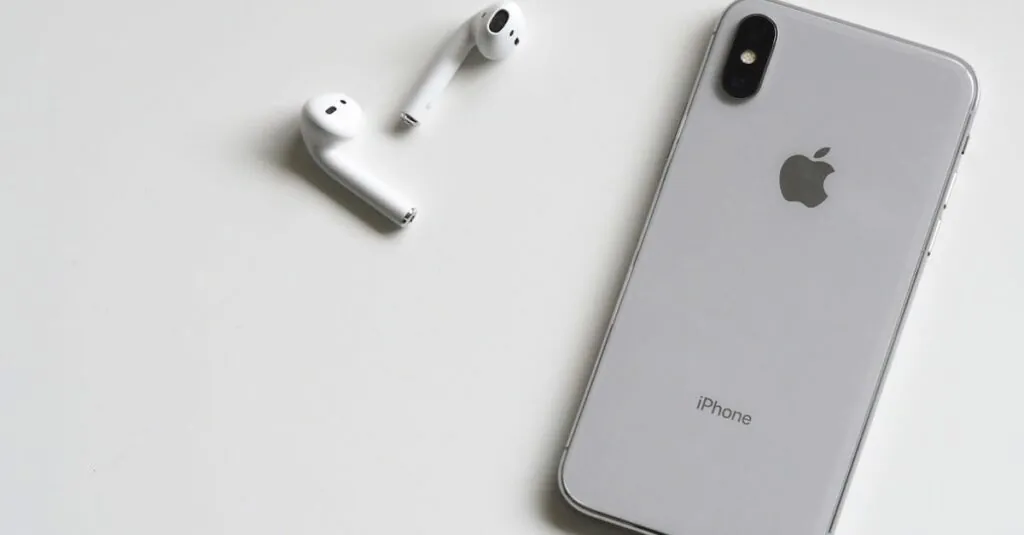Table of Contents
ToggleFor those who’ve ever found themselves straining to hear their favorite tunes or podcasts through their AirPods, you’re not alone. It’s like trying to catch a whisper in a rock concert! Luckily, cranking up the volume on your AirPods isn’t rocket science. With just a few tweaks on your iPhone, you can transform your listening experience from “huh?” to “whoa!” in no time.
Understanding AirPods Volume Limits
AirPods feature built-in volume limits that manage maximum sound output to protect users’ hearing. Apple’s software adjusts these limits based on various factors. Sound levels may vary according to content type, device compatibility, or current settings.
Users commonly find that the volume appears lower when using AirPods compared to standard headphones. Adjusting settings on the iPhone can help maximize volume output. The Sound Check feature, when enabled, normalizes playback levels, which may prevent tracks from reaching maximum volume.
Volume bumps can also occur due to environmental factors. Background noise and the fit of AirPods influence perceived loudness. Properly sealing the AirPods in the ears helps boost audio clarity and intensity.
Both AirPods Pro and AirPods Max include features that enhance sound experience. Active Noise Cancellation and Transparency Mode allow for better sound management in various environments. Utilizing these features can assist in hearing desired audio over competing sounds.
Regular software updates from Apple often include enhancements for volume controls. Keeping devices updated ensures access to the latest audio management capabilities. Changes sometimes improve overall sound performance when using AirPods.
Familiarity with iPhone’s settings can further help boost overall volume. Users can navigate to Settings, then Sound & Haptics, ensuring the volume slider is at an adequate level. Testing different audio sources can also reveal variations in loudness.
Adjusting iPhone Settings
Adjusting the iPhone settings enhances the audio experience when using AirPods. Follow these methods for optimal sound output.
Volume Control Methods
Increase the volume directly using the volume buttons on the side of the iPhone. Check the Control Center for additional options by swiping down from the top-right corner. Users can access the audio playback slider to boost sound levels. Adjust volume settings for different audio apps to find the best setting. Restarting the AirPods sometimes resolves sound issues for smoother playback.
Audio Accessibility Options
Explore the Accessibility menu in the iPhone settings for audio enhancements. Activate features such as Mono Audio to combine sound channels for improved clarity. Adjust the Headphone Accommodations feature, allowing customization of sound frequencies. Users can also enable Sound Check to balance playback levels across various content. Adjusting these settings results in a potentially louder and clearer listening experience.
Enhancing Sound Quality
Improving sound quality on AirPods enhances the listening experience. Several adjustments maximize audio clarity and loudness.
EQ Settings for Music
Accessing the EQ settings on the iPhone helps tailor sound profiles. Navigate to Settings, then Music, and select EQ to choose a preset. Popular options such as Bass Booster or Treble Booster add depth to the audio. Adjusting these settings makes a significant difference in sound quality across various genres. Experimental playlists can highlight the effectiveness of chosen settings. Individual preferences guide EQ adjustments, ensuring listeners find the ideal mix for their tastes.
Third-Party Apps
Exploring third-party apps offers additional sound enhancement options. Several apps cater to those seeking more control over audio settings. Equalizer FX, for example, allows custom EQ setups tailored to specific music genres. Users can find apps that include sound effects like reverb or surround sound features. Many of these applications provide a user-friendly interface for easy adjustments. Testing different apps reveal unique sound profiles, optimizing the AirPods experience to individual preferences.
Cleaning Your AirPods
Cleaning AirPods ensures optimal sound quality. First, use a soft, lint-free cloth to wipe the exterior. Microfiber cloths work particularly well for avoiding scratches. Next, check the speaker meshes for dirt or debris. A dry cotton swab or an anti-static brush can effectively remove buildup from these areas.
Another area to focus on is the ear tips for AirPods Pro. Removing the silicone tips allows for a thorough cleaning. Mild soap and water will clear any grime. After washing, allow them to air dry completely before reattaching.
Utilizing a small amount of rubbing alcohol on a cloth can help disinfect the surfaces. Carefully avoid getting moisture in any openings while cleaning. Regular maintenance prevents sound muffling caused by dirt accumulation, enhancing the listening experience.
Maintaining a clean charging case is equally important. Dust and lint can obstruct charging ports. A quick wipe inside the case with a dry cloth keeps connections optimal.
Inspecting AirPods periodically helps identify if more extensive cleaning is necessary. Developing a cleaning routine can ensure consistent sound quality and comfort. A viable cleaning schedule might include thorough checks every month or after extensive use. These simple steps contribute significantly to improving audio performance.
Improving the sound quality of AirPods on an iPhone is straightforward. By making a few simple adjustments in settings and exploring available features users can significantly enhance their listening experience. Regular maintenance of AirPods ensures optimal performance and clarity.
With the right tweaks and tools users can enjoy louder and clearer audio that suits their preferences. Whether it’s through adjusting EQ settings or utilizing accessibility features the possibilities for a personalized sound experience are vast. Embracing these tips will lead to a more enjoyable audio journey with AirPods.







